The 3rd Gen paints from AK Interactive are popular among many pro painters and high-profile YouTubers. But are they suitable for you if you are more of a beginner or average painter, or should you opt for newer paint ranges like Warpaints Fanatic or Two Thin Coats? In this video, I’ll be reviewing not only all 236 AK 3rd Gen paints, including the brand-new Color Punch label but also reveal the IMO biggest issue with this paint range and how to overcome it.
Many of you have often asked me in the comments of my videos if I could test the 3rd Generation acrylics range from AK Interactive, even though it’s been out for a quite a while now. Your wish is my command. I’ve been using AK paints for several years, so I knew what to expect, but for this review, I’ve acquired the complete core range of 230+ colours, including the brand-new Color Punch paints.
These items were provided by AK Interactive. Thoughts and opinions are our own.
Actually, this is not all, as the 3rd Gen range has a few more expansions. There is the AFV series with 80 additional colours for tanks and other combat vehicles, the Air series which is actually not an airbrush range but a selection of 120 colours for painting aircraft models, plus the Figure range for painting busts and larger models with 20 more colours.
In this video, I’ll be looking at the core “General” range which is the best choice for tabletop and scale model painters, as it offers everything you need from regular acrylics to metallics plus a couple of useful additives and effect paints. There is one thing I don’t like about this paint range, you might have a hunch of what it could be when looking at the official colour chart. But more about that later, let’s go through all paint types of the core range step by step.
I want to start with the metallics because, in my opinion, metallic paints are always a good indicator of the quality of a paint range.
Metallics have their ups and downs
The General range has a total of 20 metallic colours, and you can recognise them by this blue label. Alongside staples like silver, gold, and various bronze and copper tones, there are also some coloured metallics, which is quite cool as not every range has those. AK paints are available in 17ml dropper bottles of standard size. Unfortunately, the bottles do not contain pre-installed mixing balls, and that’s a problem because the metallics tend to separate. This means that over time, the denser pigments separate from the transparent binder medium and sink to the bottom. I didn’t have this problem that much with the darker metallics, but with the lighter ones, simply shaking wasn’t enough. Instead, I had to use my vortex mixer to get those paints to the perfect consistency. Did you have a similar experience? Let me know in the comments.
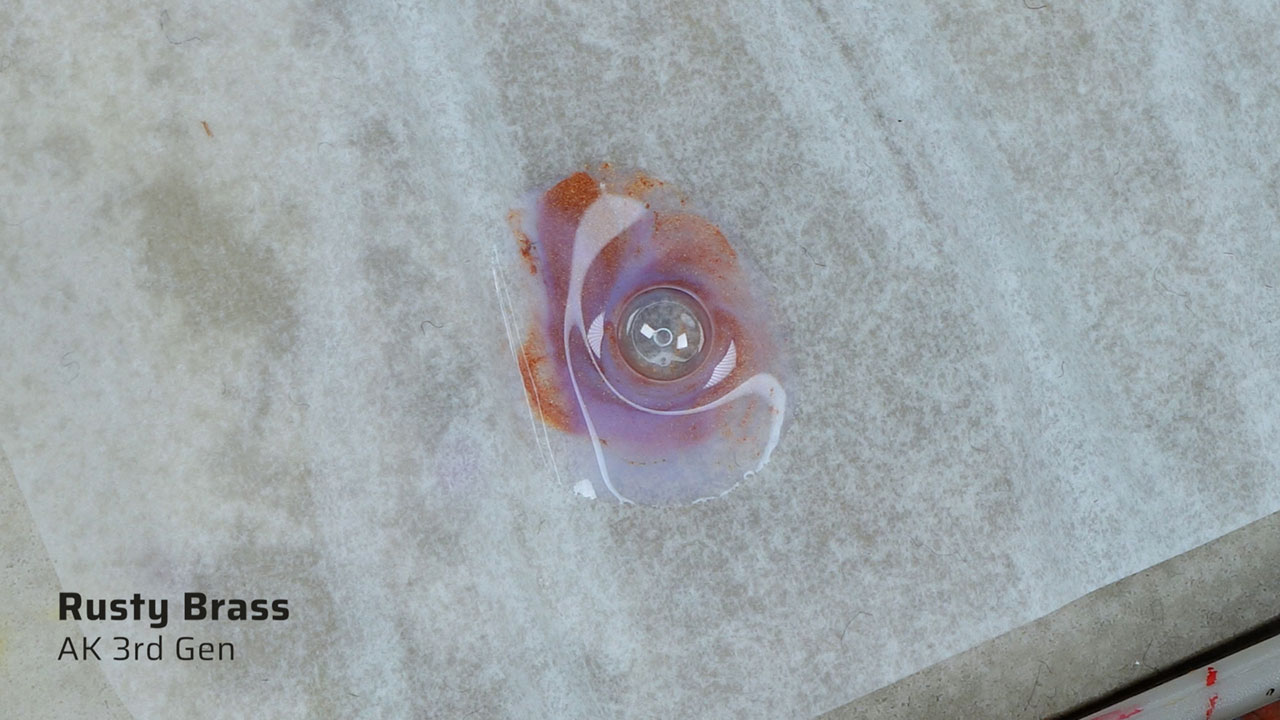

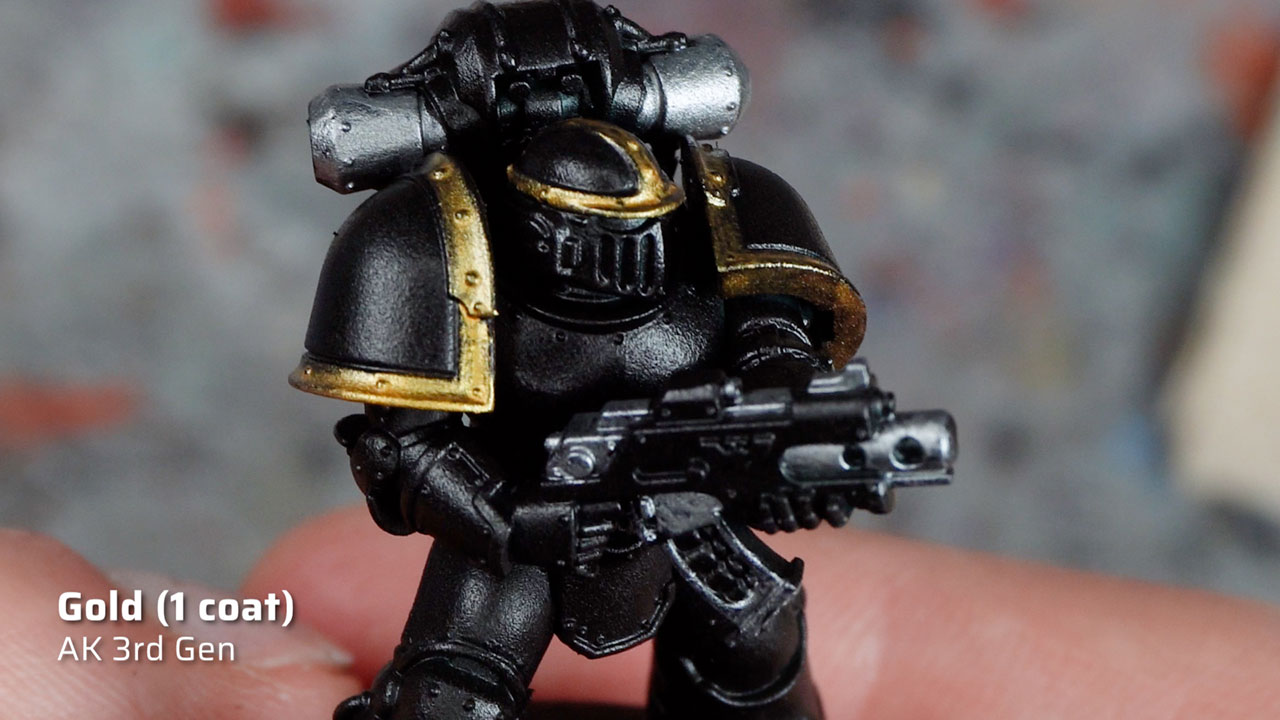

However, once you’ve put in the work, you’ll be rewarded with a beautiful sparkling finish with very fine metallic particles. The consistency is a bit on the thinner side, but this helps to apply the paint smoothly. The coverage with the darker colours is very good, but the lighter metallics pose some problems here too, as they are noticeably less opaque, especially the four white-silver colours Dark Aluminium, Aluminium, Silver, and Pearl, as well as the light gold tones. Perhaps due to the excessive shaking and mixing, I sometimes had the issue of the paints throwing many micro bubbles, which don’t disappear completely when drying if you’re not careful.
Overall, the metallics have their ups and downs. I love the finish, but for the lighter ones, I would rather go for other paint ranges such as Pro Acryl (check out my review here) or Two Thin Coats (review here). The darker metallics are really good, don’t get me wrong, but the lighter ones bring down the overall result for me.
That’s a bit of a rough start; I hope this review doesn’t go downhill from here… Before I dive into the regular acrylics and the new Color Punch paints, let’s briefly touch on the additives, effect paints, and inks.
Additives, effect paints & inks
With the additives labelled in grey, you get some useful mediums that you can mix into paints to tweak their finish, as well as various varnishes. They do what they’re supposed to do, really solid products.
The effect paints are quite new additions to the range, they have a light green label. So far, there is a blood paint, which is quite dark like old dried blood, a pastey viscera paint, and a chipping effect. Perhaps these are not my most favourite blood paints, as I prefer a more comic-book look, but with some experimentation, I’m sure you can pull off quite unique effects.


Something that’s no longer available are these brown labelled inks, as they have been replaced by AK’s new range in pipette bottles. Unlike other inks such as Game Color or most Contrast and Speedpaints, the brown label AK inks contained a high proportion of opaque, covering pigments. This means that they were only semi-transparent and visible even on dark basecoats. Think of Nihilakh Oxide from Games Workshop which has quite a similar feel. They were lacking in terms of saturation, which is why they’ve probably been replaced with the new range. They were quite unique, but I think they would have been more useful if there would have been more brown and rust colours for weathering.
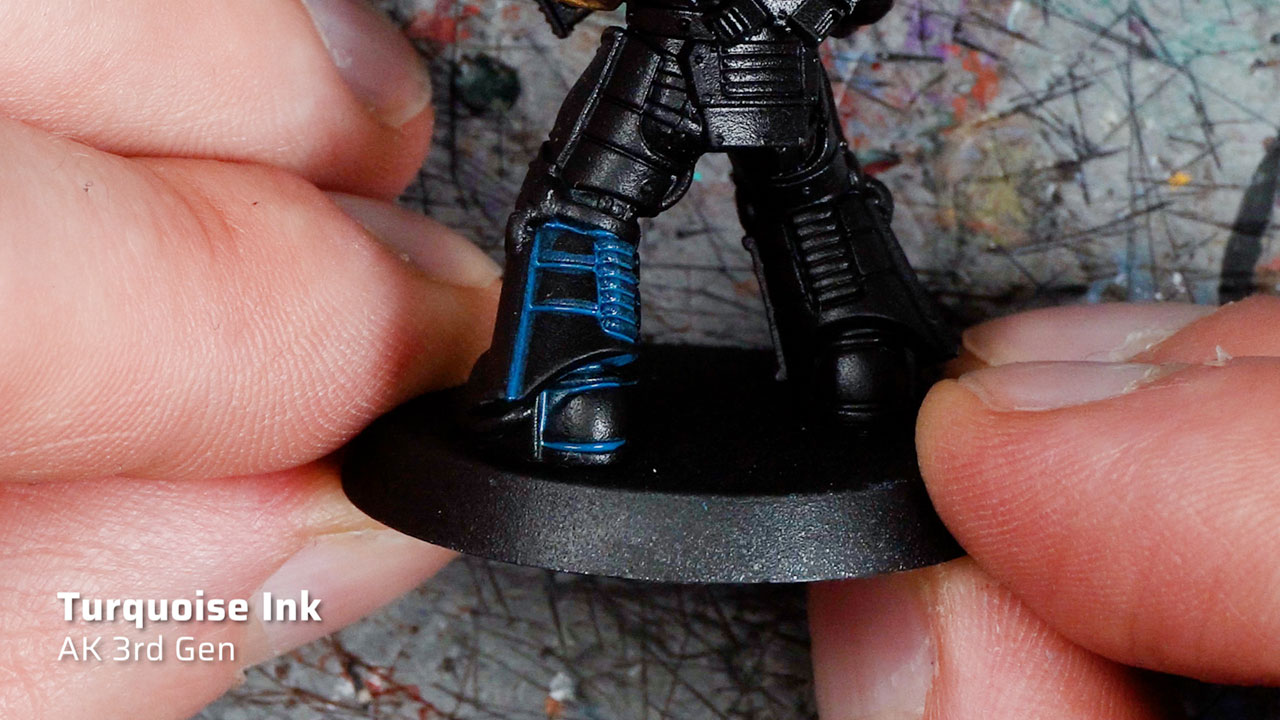

Field testing the acrylics
Let’s take a look at the bread-and-butter part of the range, the regular non-metallic acrylic paints. Will these provide us with an answer to why AK 3rd Gen has such a good reputation among pro painters? Let’s find out.
The three/four sublabels
The regular acrylic paints come in not one but three different labels, actually four counting the new Colour Punch paints. First, there are the yellow label Intense colours. Don’t confuse these with the likes of Citadel Base paints or the old Citadel Foundation paints. They are NOT designed to be super covering. Instead, they contain a high proportion of pure pigment, making them extra vibrant at the expense of opacity.
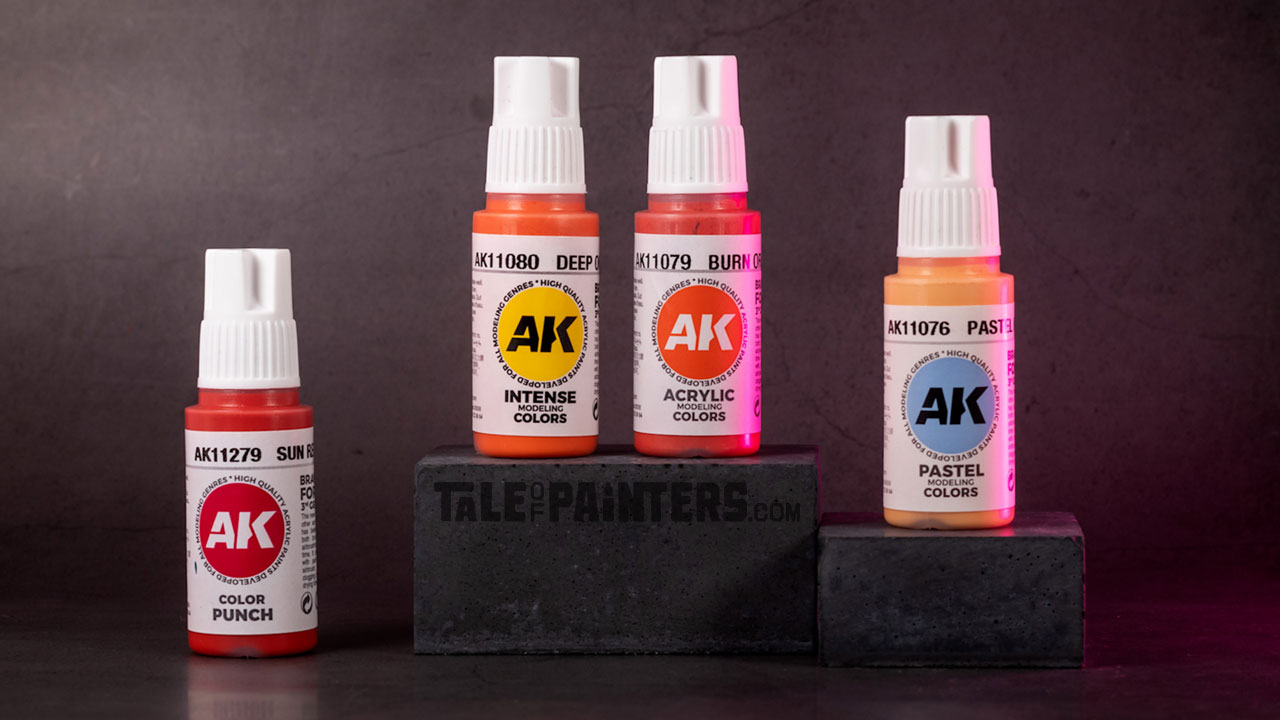

Next we have a handful of pastel colours with a cyan blue label. These are extra light colours you can use for extreme edge highlights or for brightening up darker colours. Having tried them all, I’m not sure if they really needed their own label. I think they could have been part of the orange label colours, which make up the majority of the range. Here you will find all the regular non-metallic paints, but to make things a bit confusing, the orange label also has a couple of fluorescent colours and Clear paints sprinkled in. The 5 fluo paints are quite thin and weak like fluorescent paints usually are, while the 5 Clear paints are highly glossy inks that can be sprayed through an airbrush as transparent filters for example. Personally, I think it would have made more sense to give these their own labels instead of the pastel colours.
Paint performance
But enough of the nitpicking, how do the paints perform? Well, with the acrylics I had less of a separation issue than with the metallics. I only encountered it with a few colours, mainly the Intense label ones, and shaking them was usually enough to restore their consistency. Speaking of consistency, I feel it’s quite nice, and probably one of the ranges’ main selling points. It’s not too thin, not too thick, and perhaps most importantly, very consistent across the board. By that I mean hardly any differences in thickness and density between the various colours. The application is nice and smooth, they have a good flow, and they thin well without breaking apart, for example, when glazing. The self-levelling properties are good, not quite as good as with Two Thin Coats or Pro Acryl, but still in the top tier. Whether it’s basecoating, highlighting, or dry brushing, I feel like the paint is working with you and not against you. They dry to a matte finish with a slight sheen, so they’re not super flat, but also not as satin as Games Workshop or The Army Painter. One thing I noticed is that a lot of colours become darker in their dried state, which is also a thing for Pro Acryl paints for example.
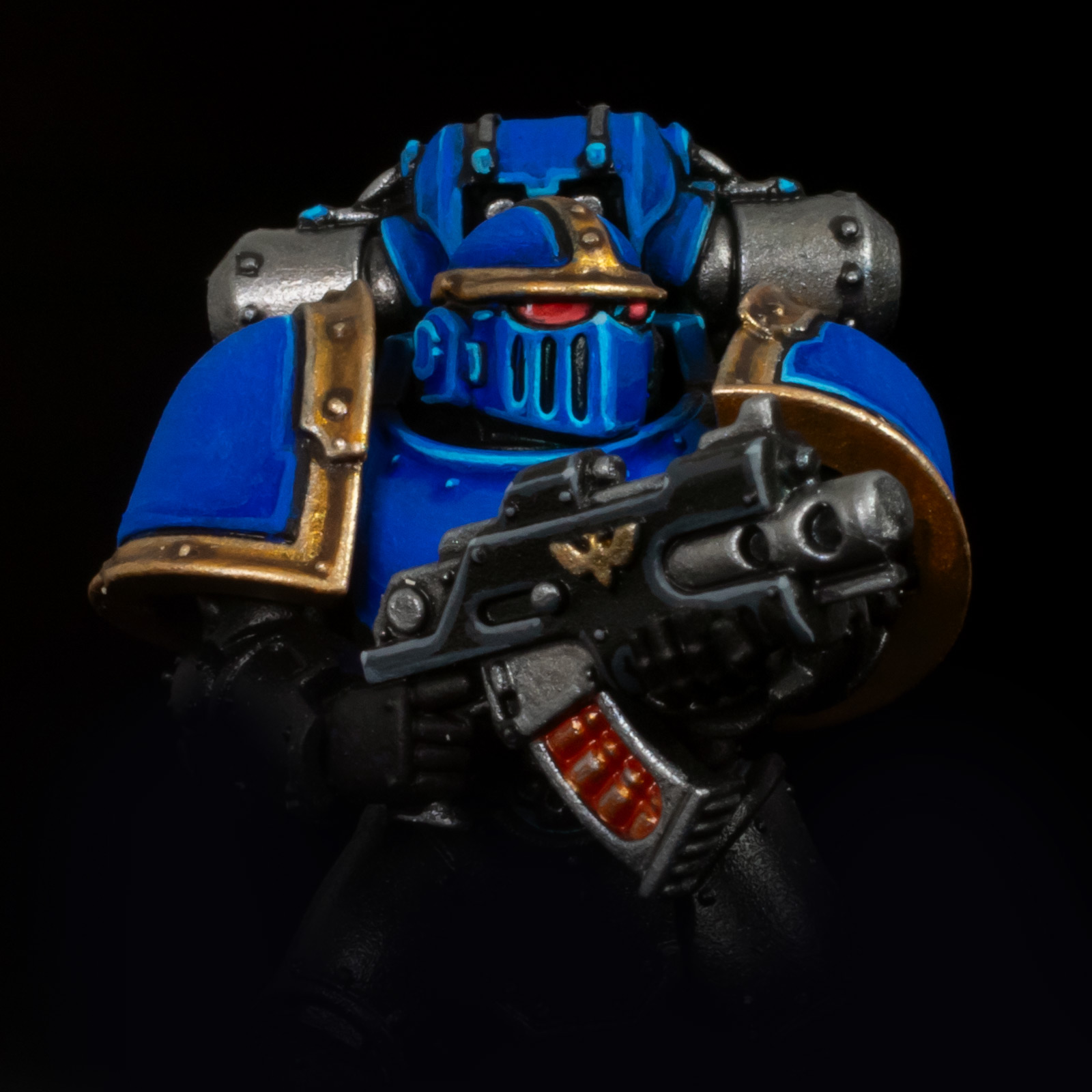

Airbrush & brush coverage
When it comes to airbrushing 3rd Gen paints I have read mixed reviews online. Some posts were very positive, others seem to have had problems. I have tested a few colours and I have to say that once you get a feel for the correct thinning ratio, I was able to achieve very good results. As always, I used my trusted Vallejo Paint Thinner with a drop of flow improver, but AK also offers their own range of thinners.


But what about brush coverage? Actually pretty good, I’d say better than with Games Workshop and on par with Pro Acryl. But not quite as good as with paint ranges like Two Thin Coats (review here) or Warpaints Fanatic (review here), which feature a very high amount of opaque pigment. In general, AK 3rd Gen went for a higher proportion of pure colour pigment, which results in higher saturation, especially with the brighter and more vibrant colours. Perhaps that’s why they’re popular among pro painters who don’t mind applying an extra coat or two. Recently I compared 21 yellow paints from 14 different brands for vibrancy and opacity, make sure to check out the results here.
The “big” issue
I have one major gripe, and I believe that those who don’t have much experience with colour theory will struggle with it as well. And that’s the official paint chart, more precisely its lack of organisation. Other paint ranges like Two Thin Coats or Reaper are organised into triads, which make it easy for beginners and even colour-blind people to understand which colours go together. Warpaints Fanatic are even structured in sets of six steps from dark to light, with a graphic printed on the bottles. In contrast, AK 3rd Gen seems like a chaotic bunch of colours, and it doesn’t help that the range has that many similar shades. Need five almost identical dark greys that differ only in nuances? Or six almost identical medium reds? Well brilliant, then AK 3rd Gen is right up your alley.
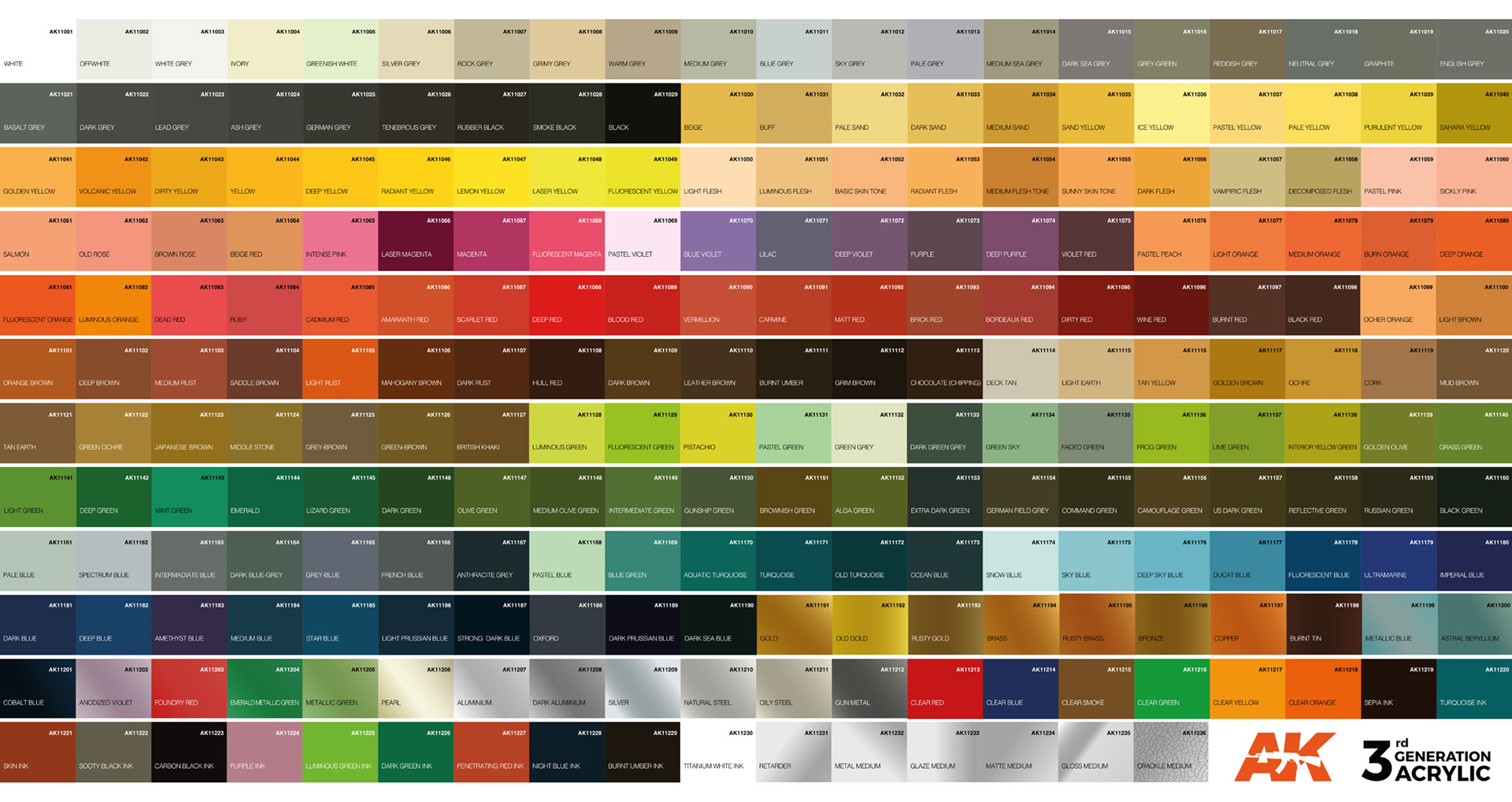

Don’t get me wrong. Choice is great, especially if you are a paint nerd and know the designations of all the fundamental pigments in your sleep. But good luck determining the differences based on the official chart, as it is, like all digital paint swatches, not very accurate. This makes buying paint a gamble, especially online, where you have to rely on product photos provided by the manufacturer. This very issue actually held me back from investing more in the 3rd Gen range for a long time because I simply didn’t know which colours to add to my collection. And because it annoyed me so much, I sat down and came up with a solution.
I painted all 236 colours plus the discontinued inks and Deep Shade washes on plasticard, professionally photographed them, and created one of my hand-painted colour swatches. For this, I’ve reorganised the colours in families, for example, grouping all warm reds from light to dark, then all cool reds, all muted reds, and so on. I also made an alternative version that’s identical to the order in the official paint chart, so you have that as well. And of course, the chart is also compatible with my other charts for Citadel, The Army Painter, Vallejo, and Two Thin Coats, allowing you to cross-compare different paint ranges, for example, to convert old paint schemes or tutorials from White Dwarf. You can find my hand-painted swatches for a small donation on Patreon, and I think they make expanding your paint collection much easier and help you avoid making any more purchasing mistakes.


This hand-painted swatch is available in my Patreon shop for a small donation (or by becoming an Autarch tier member). I also have swatches for Citadel Colour, Vallejo Game Color, Warpaints Fanatic, and Two Thin Coats – all cross-compatible with each other so you can compare colours across different brands. Check out my shop for details.
I hope that AK will soon come up with a guide for recommended colour combinations on their own, as Vallejo did with their revised Model Color Range, which is the counterpart to AK’s 3rd Gen range. Check back to Tale of Painters, as a review of the new Model Color formula is coming soon.
The brand-new Color Punch paints
I still have to talk about the brand new Colour Punch paints. So what are these, and do you need them? In the video, I mix Intense Yellow with Colour Punch Dragon Blood, which is a warm purple. As you can see there, the intermediate tones are not losing much of their vibrancy. For comparison, I mixed TTC Yellow Flame with TTC Royal Cloak, both from the Two Thin Coats range, which contain a high proportion of opaque pigments (usually white or grey).


Can you see the difference? While fine on their own, in direct comparison with AK they seem significantly desaturated, and the in-between colour appears dirtier and brownish. So essentially, Colour Punch are like the yellow label Intense paints, containing very rich and pure pigments, except that they tend to feature darker shades and tertiary colours that you can use to add depth to your shadows and paint mixes.
If you want to learn to paint at a high level using a more classic artist palette, or perhaps already do and value pigment purity, and are attracted to the Colour Punch palette, I’d say give them a try, you can get them all in a High Intensity set. For those who prefer quick results and high opacity, I think they are far from essential.
Value
With an RRP of £2.90 / 2.75 € euros per 17ml bottle, AK 3rd Gen paints are competitively priced alongside Vallejo, even undercutting The Army Painter’s new Warpaints Fanatic range. Considering the quality they offer, this pricing is more than fair. However, it’s worth noting that the price outside the EU is higher, typically around slightly over 5 dollars in most US online stores. Additionally, discounts are often available for these paints:
You can find the latest hobby products at our 🇬🇧/🇪🇺 partner stores Wayland Games, Element Games, and Firestorm Games, at 🇩🇪 Taschengelddieb and PK-Pro, and at 🇺🇸 Noble Knight Games with a welcome discount of up to 10–15% over RRP. Using our links helps to support Tale of Painters at no additional cost to you, so thank you very much for using them!
I hope you found this review helpful, feel free to leave a reaction or comment below, or post your questions here or discuss on our Discord channel.
8.0Score
Pros
- Great all-round paint suitable for all skill levels
- 249 colours to choose from, colour-coded labels
- High luminosity with still high opacity
- Affordable
Cons
- Lighter metallics are quite weak
- Metallics and Intense paints tend to separate
- Official paint chart is confusing and not very accurate
Final Verdict
To come back to the question posed in the intro, would I recommend the paint range for beginners and advanced painters alike? Well, except for the metallics, it's a very well-balanced paint range. While they may not be the most opaque paints, AK paints boast vibrant pigments that offer a high level of luminosity while not sacrificing coverage entirely. Unlike some of the colours in the Warpaints Fanatic range, they avoid a pastel-like appearance, maintaining their vibrancy on the miniature. Therefore, I can recommend the paint itself for painters of any skill level.








Just wondering why are you putting Matlics on a wet pallet…. isnt that a big no no what ever the brand.
Hello I was wondering if you have any recommendation on which third gen Green to use for salamanders